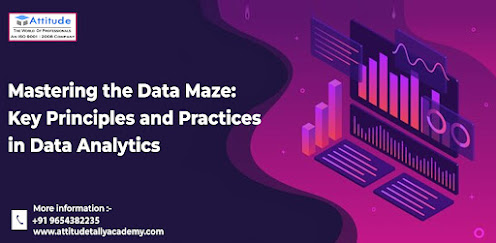Mastering the Data Maze: Key Principles and Practices in Data Analytics
Introduction
In
the era dominated by information, businesses face an ongoing challenge of
navigating the intricate data landscape to make well-informed decisions. The
surge in data analytics has elevated the importance of mastering the data maze,
making it an indispensable skill for organizations striving for a competitive
edge. This blog is an exploration of the essential principles and practices in
data analytics that empower businesses to engage in impactful data-driven decision-making
and conduct effective information analysis.
Navigating
the Complex Data Maze
The
data maze symbolizes the expansive and intricate landscape of information
amassed by organizations in their day-to-day operations. Successfully
navigating this maze requires businesses to adopt data analytics—a discipline
encompassing the inspection, cleaning, transformation, and modeling of data to
extract valuable insights. However, achieving this requires a commitment to key
principles ensuring accuracy, relevance, and actionable outcomes.
Uncompromising
Data Quality
At
the core of any effective data analytics strategy lies the quality of the data
itself. The adage "Garbage in, garbage out" resonates in this
context, underscoring the importance of flawless input data for reliable
output. To maintain the integrity of their datasets, businesses must prioritize
data quality assurance through rigorous validation processes and cleansing
techniques.
Defining
Clear Objectives for Analytical Success
Before
delving into the data, it's imperative to establish clear objectives for the
analytics process. This involves understanding the specific questions the
organization seeks to answer and defining key performance indicators (KPIs).
Aligning analytics efforts with strategic goals enables businesses to extract
meaningful insights directly contributing to decision-making processes.
Actionable
Data-Driven Decision-Making
Guided
by these principles, let's delve into practical applications of data-driven
decision-making, where businesses increasingly recognize the power of
harnessing data to inform and validate their strategic choices.
Extracting
Insightful Value from Raw Data
Information
analysis is the process of examining data to draw meaningful conclusions.
Employing various statistical and computational techniques reveals patterns,
trends, and correlations within the data. Businesses can leverage these
insights to enhance operational efficiency, optimize resource allocation, and
identify new opportunities for growth.
Best
Practices for Effective Information Analysis
To
ensure effective information analysis, organizations must adopt best practices
that enhance the reliability and relevance of their findings.
Harness
Advanced Analytics Techniques:
Embrace advanced analytics techniques like machine learning and predictive
modeling to uncover complex relationships within the data.
Leverage
Visualization Tools: Utilize
data visualization tools to present complex information in a comprehensible and
actionable format, facilitating better understanding and decision-making.
Encourage
Cross-Functional Collaboration:
Foster collaboration between data analysts, domain experts, and decision-makers
to ensure that insights align with business goals and objectives.
Navigating
the Future: A Masterclass in Data Mastery
In
conclusion, mastering the data maze demands a strategic approach to data
analytics, emphasizing principles such as data quality and clear objective
definition. By embracing data-driven decision-making and effective information analysis,
businesses can unlock the full potential of their data, gaining a competitive
advantage in today's fast-paced, information-driven landscape. As organizations
navigate the evolving data terrain, those prioritizing and mastering these key
principles are poised to emerge as leaders in their industries.




Comments
Post a Comment